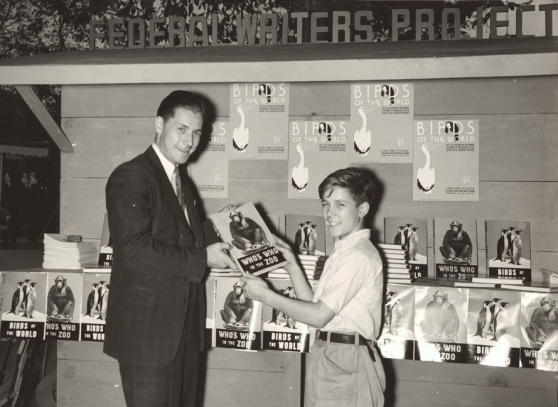Living history: Mangione’s The Dream And The Deal

Photo: Archives of American Art
It’s hard to describe what I found so appealing about Jerre Mangione’s The Dream And The Deal.
I’d owned it for years — the owner of a vintage bookstore recommended it when I came in looking for a copy of the WPA’s book on US 1 — but hadn’t gotten around to reading it for whatever reason. Maybe it’s the book’s physical appearance; it looks like one of those Modern Library versions of a classic, with all the joyless compulsory margin-noting that implies (viz. my mother’s college ML copy of The Sun Also Rises, festooned with grumbly underlines and the occasional frowny face).
But I plunged in at last, and found it…well, there are two words I really can’t stand in cultural critiques, and one of them is “immersive,” but sometimes there’s nothing for it: Mangione’s overview of the Works Progress Administrations writers’ division puts you right there, as Mangione was. His prose isn’t dressy, but it has a piquancy to it, and he chooses his photos well too; the combination seats the reader at a dented metal desk, in a cloud of pencil shavings and cigarette-infused worsted wool, at a time when “drinking self to death” was considered, if not properly an occupation, then at least a not-infrequent avocation best left unjudged:
One worker, who was inclined to drink heavily and raise hell, would often do his work in jail. Another member of the staff, a homesteader named Nelly Vandeveer, whose assignment it was to interview pioneers an record dance calls, would bring in her material on horseback and, during the winter, on skis. (117)
The Depression seems rather quaint to us now, but people starved, and killed their children so they wouldn’t, and walked without comment into lakes and off bridges (I can think of two Mangione mentions just off the top of my head, Stuart Engstrand and Weldon Kees). Writers and artists (who, with dramatists, had their own division for a while), often barely employable in good times and, in bad, often unfit physically or mentally for manual-labor opportunities the WPA might have offered, were saved by the project, which sent them out to catalog everything about their country: dance calls, as above; oral histories of former slaves taken from those of them still living, and their children; the evolution of mountain-naming in the west. Along with this came constant battling to keep the WPA and its satellites alive, which seemed to entail physically getting in front of Eleanor Roosevelt and pleading with her to intercede, and simultaneously maddening and silly politicking and nepotism at the state-project level.
Joe Gould makes an appearance, as he tends to do, toting his giant “Oral History Of The World” manuscript to “parties where his favorite act was to see how many of his clothes he could discard before being stopped by the host” (178). There is a hyphen in the word “free-lance.” The Indiana WP puts together a collection of rural “tall stories” and distributes it “in mimeograph form.” An editor is fired by proxy when a friend looms into his sunbathing light on a Cape Cod beach and offers condolences. Dozens of fascinating-sounding tomes just get shelved (I would go to some lengths to clap my eyes on Underneath New York, which is apparently rattling around some basement in Washington, and almost got shoved in a furnace by an office assistant who took a congressman’s “they should set the whole thing on fire” grousing too literally).
And consider the plight of editor Stella Hanau, who repeatedly removed a passage praising the Klan, saw it put back in, took it out, reread the ms. and found it again, on and on. Why not simply confront the offending scribe? “[A] strict office rule which prevented employees from speaking to one another on government time.” John Newsom wrote to another editor that the state guide promised to be a wonderful book…once she rewrote it from scratch because the locals’ prose was so shitty. (I’m paraphrasing. Slightly.)
Mangione does a fantastic job giving an overview of both the times; the WPA and its opponents; the significant — and, at that time, positive-ish — role Communist sympathies played in hiring practices; and the administrative struggles of such a large project, by larding it with vignettes about Gould, Richard Wright, and others. The specificity of these tableaux and judicious use of footnotes, not to mention his knowing many of the players personally and observing the timeline from the central office as it unfolded, gives the stories texture. It’s a wonderful document and it puts the era in reach for the “modern” reader; I read aloud from it to Dirk repeatedly, so someone else could enjoy the phrasings. It’s hard to find but absolutely worth it, and if anyone’s read Mangione’s memoir, An Ethnic At Large, I’d love to hear about it in the comments.
Tags: books Eleanor Roosevelt Ernest Hemingway Jerre Mangione Joe Gould John D. Newsom Nelly Vandeveer Stuart Engstrand The Dream And The Deal Weldon Kees





